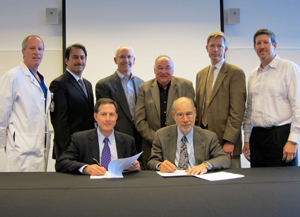January 23, 2012 - By Kris Newby

Jeffrey Shuren (front row, left) of the FDA, Harry Greenberg (front row, right) and other Stanford and Silicon Valley medical device experts at the Jan. 12 signing of an agreement to form a partnership to enhance development of new technologies.
The U.S. Food and Drug Administration has established a partnership with Stanford University to explore new ways to more quickly and safely bring lifesaving medical devices to market.
Initiated by Jeffrey Shuren, MD, JD, director of the FDA Center for Devices and Radiological Health, this collaboration is part of the agency’s larger effort to re-engineer and streamline the way the nation designs, tests and evaluates new medical technologies. The relationship was formalized with the signing of a “memorandum of understanding” on Jan. 12 during a roundtable discussion that included representatives from the FDA, the Stanford Biodesign Program and the California Healthcare Institute.
“This agreement is the first step in a new collaboration between the FDA and Stanford University to promote better scientific understanding and education concerning the development of new technologies in the life sciences and the issues that affect their safety and effectiveness” said Shuren. “We look forward to working together on collaborative research initiatives and the education of students and fellows.”
Although specific projects have yet to be defined, this agreement paves the way for both institutions to jointly apply for grants and extramural funds to support their mutual objectives. Stanford’s contributions primarily will focus on two areas — education on med-tech “best design practices” and the development of new methods for more accurately evaluating the safety of emerging medical technologies.
Paul Yock, MD, director of the biodesign program, will lead the effort to promote better design practices, which includes improving understanding of regulatory practices. The biodesign program, which is in its 11th year, provides medical technology innovation training to teams of doctors, engineers and business students who — in a year — identify a medical need, develop an invention to fill it, create a business plan, then present their inventions to venture capitalists. Since its inception, the program has led to more than 200 patents and 24 start-up companies.
Shuren, who calls Stanford’s biodesign program the “gold standard” of medical technology development programs, said that he will work with Yock to coordinate onsite cross-training of scientific personnel at the FDA and Stanford to foster the exchange of new ideas on more efficient regulatory processes.
Harry Greenberg, MD, director of Spectrum, the Stanford Center for Clinical and Translational Education and Research, is helping to lead a new initiative in predictive and precision medicine; it’s aimed at coordinating existing efforts in computational methodology, imaging and genetics with the goal of achieving higher and more efficient precision in diagnostic and prognostic efforts.
“Working with the FDA will offer Stanford trainees the potential for a firsthand exposure to the new field of regulatory science and at the same time allow FDA investigators the opportunity to become more familiar with some of the newest approaches to innovation and translation in the device and imagining space,” said Greenberg, who is also senior associate dean for research.
Kris Newby is the communications manager for Spectrum, the Stanford Center for Clinical and Translational Education and Research.
About Stanford Medicine
Stanford Medicine is an integrated academic health system comprising the Stanford School of Medicine and adult and pediatric health care delivery systems. Together, they harness the full potential of biomedicine through collaborative research, education and clinical care for patients. For more information, please visit med.stanford.edu.